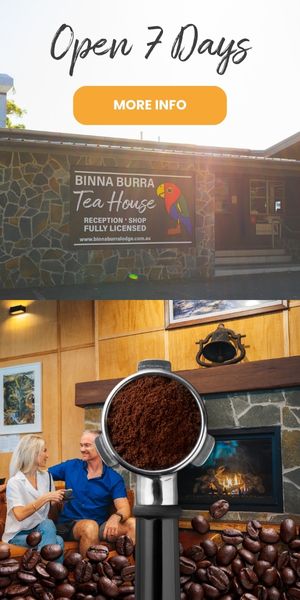On the second anniversary of the September 2019 bushfire devastation at Binna Burra Lodge
“In every walk with nature, one receives far more than he seeks.” (John Muir)
The New Bushwalker’s Precinct is now OPEN at Binna Burra
Includes the refurnished
- Bushwalker’s Bar
- Bushwalker’s Bunkhouse
- Heritage Reading Room
… and the
- Australian BUSHWALKING CHRONOLOGY – from 1888 to 2021
‘At Binna Burra we want to celebrate the history and culture of bushwalking right across Australia’ said Steve Noakes, Chairperson of Binna Burra Lodge and Councillor, National Parks Association of Queensland. ‘The formation of both the National Parks Association and Binna Burra Lodge had its roots with bushwalking into the National Parks and other protected areas of Queensland.
Bushwalking Queensland (BQ) describes bushwalking as an Australian term for recreational walking in bush land or other natural areas. It is usually done within National Parks or other protected areas, either on designated tracks or completely off track. Alternative terminology for bushwalking includes hiking, tramping, hill walking, rambling, trekking. As the State organisation for organised bushwalking, BQ advises that bushwalking should not be undertaken without some forethought. ‘It is essential that bushwalkers properly prepare themselves with suitable clothing, equipment, food and water to ensure a safe and enjoyable bushwalk.’
Dr Melissa Harper, Honorary Research Fellow, School of Communication and Arts, University of Queensland has written what has been described by Patti Miller as a ‘sure-footed and witty’ book titled ‘The Ways of the Bushwalker. On foot in Australia’ (2020). For sale at the Binna Burra Tea House, Miller describes the book an ‘An absorbing exploration of the story of bushwalking in Australia. It’s a well-researched history, not just of walking, but of our changing relationship to the natural environment, of coming to know its unique beauty and its power to both inspire and restore the body and spirit. A compelling read for anyone who loves the Australian bush.’
Especially in these current time of the COVID pandemic, bushwalking is good for the soul. It impacts on people in many different ways. After the 2019 bushfires that devasted Binna Burra Lodge, Mary-Rose MacColl’s ‘Obituary for Binna Burra’ published in the Guardian recalled:
‘I do not come from a hiking family – we never once visited a national park – but that first experience began for me a lifelong love affair with this national park in particular and national parks more generally. And what a gift it has been. Like a mother, the rainforest at Binna Burra takes you in its arms. In one way or another, I have been in those arms ever since.’
The Bushwalker’s Precinct @ Binna Burra incorporates the Includes the refurnished Bushwalker’s Bar on the lower floor of the historic Groom’s Cottage (1934) with the cosy Heritage Reading Room on the second floor. Adjacent is the refurbished Bushwalker’s Bunkhouse.
In keeping with the commitment Binna Burra Lodge has to its Reconciliation Action Plan, each of the four Bushwalker’s Bunkhouses will carry a local indigenous name of tracks or lookout points within Lamington National Park – Ballunjui, Gwongooral, Kweebani, Yangahla.
This form of budget accommodation is the perfect option for rest and recuperation before or after a hike through Lamington National Park. Each bunkhouse features:
- 4 x USB charging ports
- Heavy duty, air tight storage containers
- Vinyl floors
- Large opening slat windows
- Nearby access to bathroom facilities and shared fire pits
- Linen hire available when booking, or BYO
The Bushwalker’s Bunkhouse also features:
- a large wall map highlighting all the trails and key points of interest to be discovered on the Binna Burra side of Lamington National Park
- the Australian Bushwalker’s Chronology, recording the establishment years of the formal Bushwalking Associations across Australia since 1888

Notes:
(Sources: https://parks.des.qld.gov.au/parks/lamington/about/culture)
Lamington’s rugged landscapes are the result of tremendous changes to the Earth’s surface—changes that are still occurring. The waterfalls, cliff lines and mountain peaks we see today are remnants of an ancient landscape that reaches back into the Earth’s history, some 300 million years.
After thousands of years of First Nations people walking through the mountains and rainforests, the first European bushwalkers who saw the McPherson Rangers would have been explorers Logan, Fraser and Cunningham, who saw the rugged mountainous area from Mount Barney’s peak in 1828.
The first Europeans to bushwalk in the area now known as Lamington National Park were surveyors Francis Edward Roberts and Isaiah Rowland. Between 1863 and1866 they surveyed the Queensland–New South Wales state border along the highest peaks from Point Danger to Wilsons Peak. Bilin Bilin, a Yugambeh man and members of his family and community carried equipment and identified trees and animals. Many landmarks were named using First Nations peoples’ words. The Border Track in Lamington National Park follows part of the survey party’s original route.
The arrival of Europeans changed the First Nations peoples’ lifestyle forever. The newcomers did not understand the foraging needs of these groups even though the natural resources must have seemed vast.






















